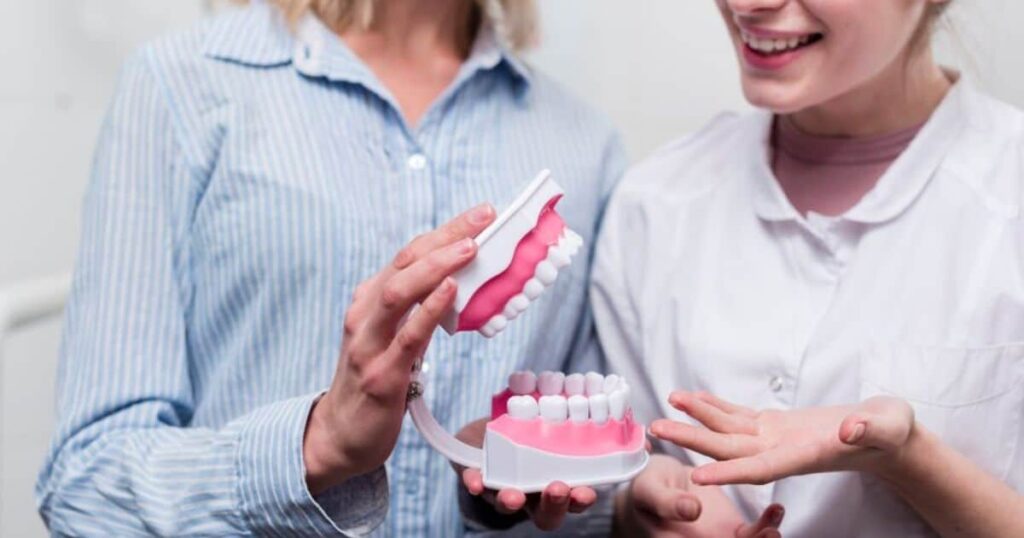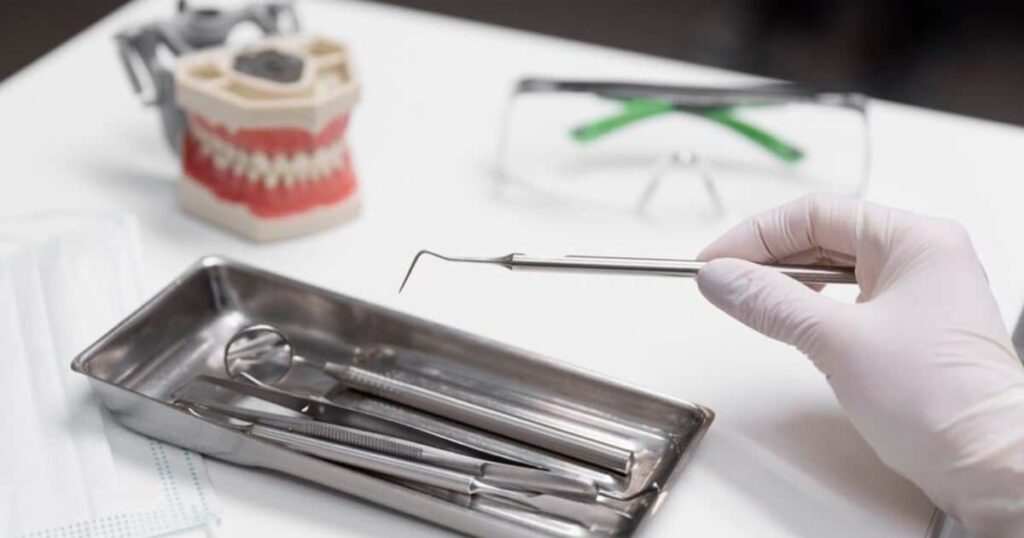Losing some or even all of one’s natural teeth was once an accepted part of growing older. Today, modern dentistry offers excellent solutions to repair one’s smile and restore the ability to eat, speak, and feel confident in public. Complete and partial dentures are customized prosthetics that replace missing teeth and supporting gum tissues.
For those missing more than just a couple of teeth, dentures can be the compassionate, budget-friendly answer to getting your bright, joyful smile back. The results can be life-changing. Dentures restore far more than just one’s teeth – they renew self-confidence and quality of life.
There are some key differences between complete dentures that replace all upper or lower teeth and partial ones that fill in spaces while still utilizing remaining natural teeth as anchors. This article will walk through the process of getting fitted for dentures tailored to your unique mouth, a comparison of full and partial denture options, and tips for adjusting to your new smile.
The Process of Getting Fitted for Custom Dentures
The process of getting dentures tailored specifically for your mouth includes several key steps:
- Dental Examination: Discussion of dental history, needs, and concerns with an oral examination of tissues, existing teeth, etc. X-rays may be taken.
- Impressions: Molds made of teeth arches and soft tissues. Wax rim measurements for jaw positioning may be made.
- Wax Try-In: Try on wax model dentures to evaluate fit and appearance. Recommend changes at this stage if needed.
- Delivery: Custom acrylic dentures created and inserted. Assess comfort levels, and ability to eat and speak. Adjustments made.
- Follow Up: Schedule follow-up appointments to check fit, and comfort and make any final adjustments. Recommend long-term care instructions.
Some patients require extractions of badly damaged teeth before impressions. Gums must heal completely before dentures are fitted, a process which takes several months. Some patients are candidates for immediate dentures placed right after extractions.
What are Partial Dentures?

Partial dentures are a removable solution when only a few natural teeth remain. A metal and/or acrylic framework fits around the existing teeth with artificial teeth attached. Partial dentures prevent remaining teeth from shifting and restore the ability to comfortably bite and chew.
Caring for Partial Dentures
To maximize the longevity of partial dentures and protect remaining natural teeth:
- Clean daily: Use a soft-bristled brush and cool water. Special denture cleaners can be used periodically.
- Don’t use toothpaste: It can wear down the pink acrylic material over time.
- Remove at night: Unless otherwise advised by your dentist. This allows gums to rest.
- Check the fit regularly: See your dentist if they become loose or rub painfully at all. Adjustments may be needed.
Immediate Dentures: Getting Teeth Restored Quickly
Immediate dentures allow patients to get a denture on the same day teeth are extracted for seamless restoration of smile and confidence. A preliminary impression will be taken before extractions. The denture is then created in advance and inserted promptly after removal.
Benefits include avoiding the embarrassment and discomfort of having missing front teeth during the healing period. Chewing capability is also quickly restored.
However, as jaw shape adjusts without teeth over the first few months of healing, immediate dentures usually require several relines or rebases within the first 6-12 months as they can become loose while bone remodels. A permanent set of dentures will likely be made later.
Stasis Dentures: A Temporary Solution

A stasis denture is an affordable, temporary acrylic partial or full denture worn during initial healing. It serves while waiting for:
- Bone to completely heal before getting permanent custom dentures made
- Ordering and creation of a custom denture (which takes several weeks)
- Saving funds for a high-quality permanent denture if immediate dentures were not affordable
Healing can take 3-6 months. Some patients wear stasis dentures for up to a year in anticipation of additional tooth loss. While stasis dentures offer temporary restoration, they should be replaced by permanent dentures later on.
How to Choose Between Partial and Complete Dentures
Choosing between full and partial dentures is an important decision based on several factors:
| Partial Denture | Complete Denture |
| Enough natural teeth remain to support a partial | Few/no natural teeth remaining |
| $1500 – $3000 | $1000 – $3000 |
| Requires care of remaining natural teeth too | Replaces all teeth; focus care on gums and dentures |
| Clasps may irritate cheeks. Put less pressure on tissues than full dentures. | Takes the most adjustment to feel comfortable |
| Can be disguised to blend better with natural teeth | Full replacement teeth may appear more uniform |
| Preserves some natural biting ability | Relies entirely on dentures for chewing |
Your dentist will advise if you require a partial or complete denture based on your specific oral health examination. Budget, lifestyle needs, timelines before tooth loss, and personal priorities around restoration, appearance, and comfort also impact your ideal denture solution.
Types of Removable Partial Dentures

There are 3 main types of removable partial dentures:
1. Acrylic Base with Replacement Teeth
- Typically used as an affordable, temporary option
- Quick to fabricate
- Prone to cracks; higher maintenance
- visible metal clasps around teeth
2. Cast Metal Base with Metal Framework
- Custom cast metal base formed precisely to mouth
- Very durable but higher cost option
- May have some visible metal
- Strongest option for long-term partial denture wear
3. Flexible and Clear Partial Dentures
- Discreet nylon thermoplastic base with clear clasps
- Mimics gums for a natural smile
- Lightweight yet fractures more easily than metal over time
- Costs less than cast metal options
- The great short-term cosmetic option before tooth implants
When determining the optimal partial denture design, patients must balance their budget, needs for durability, and aesthetic priorities in replacing their missing teeth.
Getting fitted for personally customized dentures is a big step in restoring oral health functionality and self-confidence. While total tooth loss was once an inevitable part of aging, today’s modern materials and denture solutions allow patients to enjoy a beautifully restored smile for years to come.
FAQ’s
Are partial dentures better than full?
For some people, partial dentures are easier to use and more comfortable than full dentures. They allow you to keep your natural teeth.
What are the disadvantages of partial dentures?
Partial dentures may need to be removed for cleaning and can loosen over time. Eating certain foods also requires taking them out.
Do partial dentures look natural?
Partial dentures can look very natural when positioned and fitted properly in the mouth. They may still look slightly different than natural teeth upon close inspection.
Can you live a normal life with partial dentures?
Yes, partial dentures allow you to eat, speak, and smile normally like before. You’ll need to adjust to caring for and occasionally removing them throughout the day.
Can I brush my teeth with partial dentures?
It is possible to brush your natural teeth with partial dentures in or out of your mouth. But it’s simplest to remove partial dentures when brushing your natural teeth and cleaning the dentures separately.
Conclusion
The choice between complete or partial dentures is an important decision for those experiencing tooth loss due to issues like decay, infection, or injury. Noticing difficulties eating certain foods, self-consciousness about one’s smile, or other teeth shifting can indicate that dentures may help. Dentures play a key role in regaining confidence and the ability to chew properly.
The dentist will do thorough exams, take impressions of the jaws, have “try-ins” with wax versions, and follow-ups to ensure a good fit and function. Partial dentures may be an option if only a few natural teeth remain. Different partial denture types include acrylic-based, metal-reinforced, clear, or flexible options depending on aesthetics and budget. Immediate dentures provide fast relief from being without teeth during healing, though adjustments in the first months are common. Additionally, temporary or “stasis” dentures offer an affordable solution while waiting for custom-fitted permanents.











